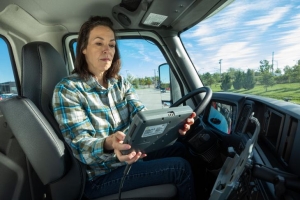
It’s no secret that the transportation industry is always looking for innovative ways to optimize company processes and streamline day-to-day routines. To stay ahead of competition and ensure customer satisfaction, both fleets and drivers often understand the importance of moving freight in a fast, efficient, and accurate manner. However, companies must also keep driver safety top-of-mind, especially in regard to long haul transportation.
In today’s digital era, there are many technology-based solutions that carriers are using to help their drivers navigate the best routes, address potential conditional issues, establish more enhanced communication channels, and avoid dangerous critical events.
Next-generation navigation tools
Advanced navigation tools are designed to enhance company operations and better meet customer needs. The technology helps users to create effective routes, optimize drivers’ schedules, balance business constraints, and fulfill orders faster and more efficiently than ever before. In addition, with the software, fleets have real-time access to each driver’s hours of service. This not only allows them to ensure compliance, but also determine their daily availability and appropriately match them with the right customers based on capacity.
Also, when planning trips, navigation technology automatically takes into account unforeseen conditions that drivers can’t control to help them get to their locations quickly and safely. For example:
- Weather: Poor weather conditions can largely impact a driver’s route and cause unsafe driving conditions. With navigation tools, drivers can automatically avoid these routes, following the most optimal directions to each point of delivery, which not only protects the drivers, but also elevates company margins and customer happiness.
- Poor road conditions: As drivers can pass through several geographic locations each day, they often encounter roads that are not well maintained. With navigation tools, they can avoid these routes as much as possible, while still ensuring they get to their destinations in a timely manner.
- Congested traffic: Whether from a major accident, road construction, or weather delays, traffic is inevitable for long-haul drivers. With advanced navigation software, drivers routes are automatically populated and designed to avoid delays from traffic as much as they can.
- Truck-restricted roads: When operating a fleet, drivers need to be cautious of roads that have low clearances, weight limits, or don’t allow trucks of a certain size. Navigation applications assist with this, as they utilize historical traffic conditions to provide the best available routes.
Advanced driver communication tools
Maintaining constant communication with drivers is critical for fleets, but it’s often a tricky and somewhat dangerous task. But mobile and next-generation communication tools have changed the game completely. Having easy, real-time access between the driver and the back office is beneficial for both parties. Today, the transportation industry has access to advanced telematics devices, allowing fleets to stay in constant contact with long-haul drivers.
With text-to-speech and hands-free capabilities, as well as robust automated driver messaging tools, fleets can now reach drivers to share important updates, without requiring them to take their eyes off the road and hands off their steering wheels. These tools provide safe and efficient communication channels so dispatchers can reach drivers when routes change, if a critical event is triggered, if orders need to be processed, and more. Additionally, these devices help drivers quickly contact their superiors if there’s an issue with their vehicles, if they encounter a problem with a delivery, or order or if they need to revise a route.
Also, these communication solutions allow companies to implement strict cell phone usage policies, as drivers no longer have the professional need to access their phones while operating their vehicles — leading to safer roadways and increased driver productivity.
Powerful critical event reporting tools
Another technology that is revolutionizing the transportation industry is critical event reporting solutions, which monitor vehicles to improve driver behavior and prevent accidents. By capturing data on hard braking, lane departure, forward collision, and overspeed, fleets can identify risky driving habits and provide counsel to avoid future safety incidents.
Today, many fleets utilize in-vehicle video solutions to improve driver training and mitigate liability risks associated with accidents and other critical events. When these insights are matched with time, location, and vehicle speed, fleets can have a comprehensive view of the moments before, during, and after safety-related events. By monitoring these events, fleet managers can work with drivers to continuously improve their overall driving habits.
What’s next?
To complete deliveries safely and efficiently, there are many duties long-haul drivers need to fulfill on a day-to-day basis, including tracking hours, loading and unloading their vehicles and driving from one location to another. While some factors are out of the driver’s control, there are solutions fleets can implement to streamline processes. As technology develops and new offerings continue to significantly improve operations, it’s critical fleets invest now to see a high ROI for years to come.
To learn how Omnitracs can help, contact us today.